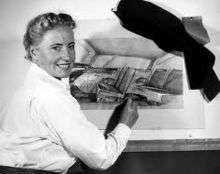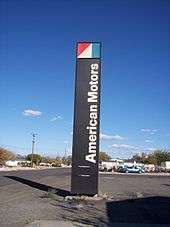Helene Rother
| Helene Rother | |
|---|---|
 | |
| Born |
1908 Leipzig, Germany |
| Died |
1999 Michigan |
| Nationality | United States |
Helene Rother (1908–1999) was the first woman to work as an automotive designer when she joined the interior styling staff of General Motors in Detroit in 1943.[1] She specialized in designs for automotive interiors, as well as furniture, jewelry, fashion accessories, and stained glass windows.
Early life
A native of Leipzig, Germany, Rother studied art at the Kunstgewerbe School in Hamburg. She also studied at the Bauhaus in Weimar. Rother moved to Paris and designed of high fashion jewelry, as well as popular little animal pins that women wore on hats and dresses before World War II.[2]
In 1932, Rother gave birth to Ina Ann Rother whose father was active in the French Resistance and on the run for years.[3]
Rother fled from Nazi-occupied France together with her seven-year-old daughter Ina, to a refugee camp in northern Africa where they stayed for four months before finding passage on a ship bound for New York City in 1941.[2]
Career
Rother's first employment in New York was as an illustrator for Marvel Comics.[4] The following year, she joined the interior styling staff of General Motors in Detroit, Michigan. She was responsible for upholstery colors and fabrics, lighting, door hardware and seat construction.[2]
Although she was Detroit's first woman automotive designer, it was downplayed at the time and her salary as reported in a newspaper was US$600 a month.[4] At this time the average wage was $200 for a man.[5] "She was one of the few women to succeed in a man's job during an era when the vast majority of women couldn't even see a glass ceiling-it was hidden behind steel doors."[6]
In 1947, Rother established her own design studio in the Fisher Building, where she specialized in designs for automotive interiors, furniture, and stained glass windows.[1] Her business was named Helene Rother Associates.[7] In 1948 she published a technical paper with the Society of Automotive Engineers (SAE) asking "Are we doing a good job in our car interiors"[8] She participated in SAE conferences describing that much can be and should be done in improving automobile interior design and the materials used at that time, summarizing what determines quality in textiles "You get exactly what you pay for."[9]
In 1949, The SAE Journal reported on Rother's work and her activities advocating women in the industry. They described her "efforts have encompassed items ranging from jewelry and accessories to several of today's automobiles, and quoted her that "even the Army is ahead of industry in employing the talents of women."[10]
Nash Motors

She was soon contracted by Nash Motors and styled the elegant interiors of most of the cars from 1948 to 1956.[5] Even the economical Nash Rambler models were prominently promoted as "irresistible glamour" on wheels. The innovative 100-inch wheelbase Rambler was conceived initially as a well-appointed convertible with its interior designed with the aid of Rother as a consultant.[11] Nash used a strategy to give the new Rambler a positive public image by avoiding it being seen by the public as a "cheap little car." It was "well-equipped and stylish" with no "stripped-down" versions.[12] The focus on design and quality features helped establish a new segment in the automobile market, as the Rambler is widely acknowledged to be the first successful modern American compact car.[13][14]
Rother designed the Rambler's interiors to appeal to the feminine eye knew because she knew what women looked for in a car and her designs featured elegant, stylish, and expensive fabrics that coordinated in colors and trim.[15] The new 1951 Rambler models were also "given the custom touch" with fabrics and colors selected by Rother that "equaled the best of interiors in American luxury cars of the period."[16]
She toured the 1951 Paris Auto Salon, and was the first woman to address the Society of Automotive Engineers in Detroit.[5] In 1953, Nash was awarded the Jackson Medal, "...since 1898, one of America's most sought-after awards," according to an advertisement, for excellence of design.[4] Many Nash sales brochures and Rambler advertisements of the time featured the copy stating: "Styling by Pinin Farina and interiors by Madame Helene Rother of Paris" as proof of the European influence on company's automobile styling.[17][18] She conferred with Pinin Farina, who styled the exterior of the 1953 Nash Airflytes, to coordinate with the interiors and new custom fabrics.[19] In 1954, the Nash Ambassadors had a big feature: the completely new interior by Rother.[20] That year, Nash merged with Hudson to create American Motors Corporation (AMC), but her influence on interior fashion in automobiles continued.
Other work
Rother purchased a home on Chicago Boulevard in Detroit, with living quarters upstairs and a studio downstairs, where she continued other independent consulting work.[2] Her clients included several tire manufacturing companies, as well as non-automotive firms. She was also responsible for designing the interiors of ambulances and hearses for Miller-Meteor.[4]
A sterling flatware pattern called "Skylark" was designed by Rother for Samuel Kirk & Son, silver craftsmen firm since 1815, that the company issued from 1954 into the late-1980s.[21] The Skylark brand and logo expired in 1997.[22]
Rother decided she wanted to begin producing art again so she went for a visit to Europe where she saw the struggle to restore or rebuild war-damaged churches and cathedrals. She also designed stained glass for American churches and had installations in the mid-1960s, mainly in Michigan,[23] such as the Beverly Hills United Methodist Church in Beverly Hills,[24] and the St. Lazarus Serbian Orthodox Cathedral in northeast Detroit with all thick "chunk" faceted glass, that was fabricated in France.[2] In 1962, the St. James United Church of Christ in Dearborn, was dedicated featuring windows and the reredos designed by Rother.[25] The glass was selected and fabricated into small pieces by a family group of craftsmen in Buche, a suburb of Paris, before being shipped from France for final assembly during the construction.[25]
Rother remains relatively unknown in the world of stained glass as women who designed stained glass, either independently or under a major studio name, were for the most part unrecognized at the time.[2]
In her later years, Rother designed large stained glass windows for churches and spent time on her horse farm near Metamora, Michigan.[1]
Legacy
In 1953, Tide, a magazine covering the sales and advertising industry and trends, wrote: "a most attractive woman, whom I have thus encountered along the periphery of advertising is Madam Helene Rother — pretty and vivacious enough to serve as a prototype of Parisian women. She is an industrial designer with an impressive record."[26]
According to automotive historian Patrick Foster, Rother is one of the important people in the automotive industry who have been overlooked or forgotten.[6] She was not the first woman to work in styling; however, "she was an early pioneer and one of the best."[6]
Notes
- 1 2 3 "Women's Automotive History Highlights" (PDF). AACA Antique Auto Museum. p. 3. Archived from the original (PDF) on 14 September 2013. Retrieved 19 March 2014.
- 1 2 3 4 5 6 Krueger, Barbara (1 June 2007). "Helene Rother (1908-1999) Windows of the Month for June, 2007 Michigan Stained Glass Census". MSU Museum. Archived from the original on 16 July 2011. Retrieved 19 March 2014.
- ↑ "The Good Animal" (PDF). Perspectives Magazine. College of Veterinary Medicine at Michigan State University: 13–15. Winter 2009. Retrieved 19 March 2014.
- 1 2 3 4 Foster, Patrick (July 2005). "First Lady of Style". Hemmings Classic Car. Retrieved 19 March 2014.
- 1 2 3 Wolff, Tamsin (September–October 2007). "Women's Automotive History Highlights" (PDF). NC Region News. 53 (5): 12–14. Archived from the original (PDF) on 9 December 2008. Retrieved 19 March 2014.
- 1 2 3 Foster, Patrick (May 2005). "Automotive Hall of Fame". Hemmings Classic Car. Retrieved 19 March 2014.
- ↑ "Recent Gifts to the MSU Museum Collection of Stained Glass Artifacts" (PDF). The Michigan Stained Glass Census Newsletter. November 2003. Archived from the original (PDF) on 21 February 2007. Retrieved 19 March 2014.
- ↑ Rother, Helene (January 1948). "Are we doing a good job in our car interiors". Society of Automotive Engineers, document 480146. Retrieved 19 March 2014.
- ↑ Christianson, George T. (1949). "The November 15th Dinner Meeting". The Supercharger. Society of Automotive Engineers. Detroit Section: 55.
- ↑ "Are we doing a good job". The SAE Journal. Society of Automotive Engineers. 57: 70. 1949.
- ↑ Medway, Sam. "Refrigerators and Two Georges: from Nash-Kelvibator to American Motors". Automobile Quarterly. 15 (2): 140–159. Retrieved 19 March 2014.
- ↑ "Report on the small cars". Changing Times, Kiplinger's Personal Finance. 7 (9): 14–15. September 1953. Retrieved 19 March 2014.
- ↑ The New Encyclopaedia Britannica. 1. Encyclopaedia Britannica. 2005. p. 333. ISBN 978-1-59339-236-9.
first modern American compact car, the Rambler.
- ↑ Szudarek, Robert G. (1996). How Detroit became the automotive capital: 100th anniversary. Society of Automotive Engineers. p. 193. ISBN 978-0-614-22229-6. Retrieved 19 March 2014.
the Nash-Kelvinator Corporation introduced the first modern compact car in 1950.
- ↑ Auto Editors of Consumer Guide (28 August 2007). "1950-1952 Rambler". auto.howstuffworks.com. Retrieved 19 March 2014.
- ↑ Flory, J. Kelly (2008). American cars, 1946-1959: every model, year by year. McFarland. p. 444. ISBN 978-0-7864-3229-5. Retrieved 19 March 2014.
- ↑ "As though it were built for you alone". Life. 33 (5): 41. 4 August 1952. Retrieved 19 March 2014.
- ↑ "1954 Nash Airflytes advertisement". adclassix.com. Retrieved 19 March 2014.
- ↑ "Nash Cars". Motor. Hearst. 99: 15. 1953. Retrieved 19 March 2014.
- ↑ Auto Editors of Consumer Guide (13 September 2007). "1954 Nash". auto.howstuffworks.com. Retrieved 19 March 2014.
- ↑ Keystone Jewelers' Directory Issue. Jewelers' Circular. Chilton's. 1954. p. 83.
- ↑ "Brand page for the SKYLARK trademark by Samuel Kirk & Son". trademarkia.com. Retrieved 19 March 2014.
- ↑ "Artist: Rother, Helene". Michigan Stained Glass Census. Retrieved 14 August 2011.
- ↑ "Beverly Hills United Methodist Church: Window of the Month". MSU Library Michigan Stained Glass Census. February 2003. Archived from the original on 12 October 2008. Retrieved 19 March 2014.
- 1 2 Sanctuary Dedication Program. Dearborn, Michigan: St. James United Church of Christ. 1962. p. 15. Retrieved 19 March 2014.
- ↑ "Surplus Obfuscation". Tide: 34. 1953. Retrieved 19 March 2014.
References
- Foster, Patrick (July 2005). "First Lady of Style". Hemmings Classic Car. Retrieved 19 March 2014.
- Foster, Patrick. "Styling Cues: Helene Rother: First Lady of Styling". Automobile Quarterly. 46 (4).
- Raymond, Alain (2007). "Un palais sur quatre roues (Palace on wheels)". La Presse (in French). Retrieved 19 March 2014.
- "Automotive History Spotlight: Helene Rother". Buying Cars Her Way. 6 March 2013. Retrieved 19 March 2014.
